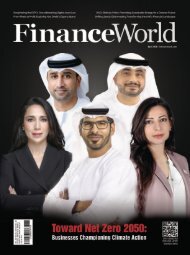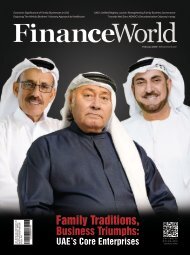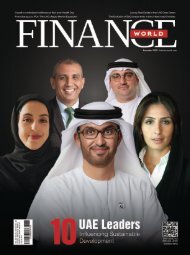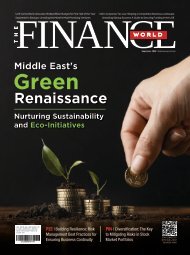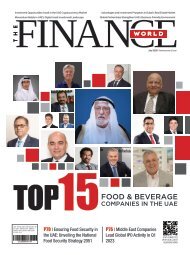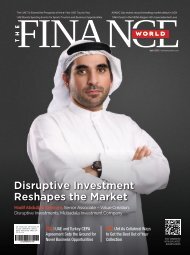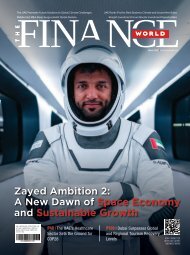The Finance World Magazine| Edition: October 2023
In this dynamic era of technology and innovation, the world stands at the crossroads of boundless possibility, where visionary endeavours and transformative innovations shape the future. This issue centres around the innovative tech startups that play a pivotal role in shaping the Middle East and North Africa Region. It highlights 20 tech startups that have gained prominence for their innovative approach and revolutionary vision. Within the ever-evolving financial landscape, the enduring strength of long-term investments is subject to in-depth analysis. Discover how strategic patience, persistence, and a keen eye for innovation can lead to long-term financial success. This edition offers a comprehensive exploration of the AI innovation landscape in the UAE, emphasizing the vibrant startup ecosystem. It provides insights into stock market trends, dynamics, and the role of AI in financial markets. Additionally, it delves into the transformative impact of technological acquisitions on various industries through mergers and acquisitions (M&A). The publication also highlights the top three robo-advisors, serving as a reliable resource for making informed and efficient investment decisions, making it a valuable guide for individuals interested in the intersection of AI and finance in the UAE. Keep yourself up to date with all financial sector news with our current news segments. Each person can find something unique from us. We believe our readers deserve real value from what we have to offer.
In this dynamic era of technology and innovation, the world stands at the crossroads of boundless possibility, where visionary endeavours and transformative innovations shape the future. This issue centres around the innovative tech startups that play a pivotal role in shaping the Middle East and North Africa Region. It highlights 20 tech startups that have gained prominence for their innovative approach and revolutionary vision.
Within the ever-evolving financial landscape, the enduring strength of long-term investments is subject to in-depth analysis. Discover how strategic patience, persistence, and a keen eye for innovation can lead to long-term financial success.
This edition offers a comprehensive exploration of the AI innovation landscape in the UAE, emphasizing the vibrant startup ecosystem. It provides insights into stock market trends, dynamics, and the role of AI in financial markets. Additionally, it delves into the transformative impact of technological acquisitions on various industries through mergers and acquisitions (M&A). The publication also highlights the top three robo-advisors, serving as a reliable resource for making informed and efficient investment decisions, making it a valuable guide for individuals interested in the intersection of AI and finance in the UAE.
Keep yourself up to date with all financial sector news with our current news segments. Each person can find something unique from us. We believe our readers deserve real value from what we have to offer.
You also want an ePaper? Increase the reach of your titles
YUMPU automatically turns print PDFs into web optimized ePapers that Google loves.
Cultural tourism investments balance heritage<br />
preservation and economic growth, overcoming<br />
challenges through responsible practices and<br />
embracing technology.<br />
Cultural tourism revolves<br />
around the idea of travelers<br />
seeking authentic cultural experiences.<br />
It includes visits to<br />
historical sites, participation in local<br />
traditions, exploration of museums<br />
and art galleries, and interactions<br />
with local communities. Rather than<br />
being mere spectators, cultural tourists<br />
actively engage with the heritage<br />
and traditions of the places they visit.<br />
Recent reports have identified the age<br />
group of 18-35 is more likely to opt for<br />
cultural tourism as compared to other<br />
age groups.<br />
Heritage preservation is absolutely<br />
necessary for attracting cultural tourists<br />
to a country and often requires<br />
substantial investments in the restoration<br />
and maintenance of historical<br />
landmarks, the protection of indigenous<br />
knowledge, and the conservation<br />
of art and artefacts. <strong>The</strong>se investments<br />
are not just a cultural responsibility<br />
but also an economic opportunity.<br />
Cultural tourism investments are<br />
made globally and continue to grow in<br />
different parts of the world including<br />
the Middle Eastern region. In recent<br />
years, Middle Eastern governments<br />
have increasingly embraced these<br />
investments as a means to stimulate<br />
economic growth and raise their global<br />
profile. <strong>The</strong> governments of the UAE,<br />
Saudi Arabia, and Oman have made<br />
substantial investments in heritage<br />
preservation. For instance, the Saudi<br />
government allocated a significant $3.2<br />
billion as part of its Vision 2030 plan,<br />
aimed at promoting cultural tourism<br />
within the country. Similarly, Oman is<br />
set to experience a remarkable surge<br />
of $7 billion in heritage and tourism<br />
investments by the end of 2025. <strong>The</strong>se<br />
investments reflect the region’s commitment<br />
to preserving its rich cultural<br />
heritage while also capitalizing on the<br />
potential economic benefits of cultural<br />
tourism.<br />
<strong>The</strong> Future Market Insight report<br />
stated that a surge of 14.4% CAGR<br />
is expected in cultural tourism investments<br />
by the year 2033. It also<br />
mentioned that the current market<br />
revenue of these investments is set to<br />
total $5,931.2 million in <strong>2023</strong>, which<br />
will increase to $22,772.0 million in<br />
2033. Another study identified cultural<br />
tourism as one of the most rapidly<br />
expanding sectors within the tourism<br />
industry, making up approximately 40%<br />
of global tourism activities. <strong>The</strong>se details<br />
signify the potential for economic<br />
benefit of preserving heritage.<br />
Cultural tourism investments have a<br />
significant positive impact on the local<br />
economy. When tourists engage in cultural<br />
tourism, they inject money into<br />
the destination’s economy. <strong>The</strong>y spend<br />
on accommodations, which support<br />
hotels and lodging businesses. Dining<br />
expenditures benefit local restaurants<br />
and eateries, while transportation<br />
costs contribute to taxi services, tour<br />
operators, and public transportation.<br />
Moreover, tourists often purchase souvenirs,<br />
supporting local artisans and<br />
shops. This spending cycle generates<br />
income and employment opportunities<br />
within the community, which, in turn,<br />
leads to economic growth.<br />
Cultural tourism is a boon to small<br />
and local businesses. When tourists<br />
are on the lookout for genuine cultural<br />
experiences and locally crafted<br />
products, they often turn to these<br />
businesses. Whether it’s buying handmade<br />
crafts, sampling local cuisine,<br />
or participating in unique cultural<br />
activities, tourists contribute directly<br />
to the success of these enterprises.<br />
In essence, cultural tourism nurtures<br />
a symbiotic relationship between tourists<br />
and local businesses, promoting<br />
mutual growth and prosperity.<br />
While the economic benefits are<br />
evident, cultural tourism investments<br />
come with their share of challenges.<br />
Striking a balance between economic<br />
growth and heritage preservation can<br />
be complex. Over-tourism, degradation<br />
of historical sites, and cultural commodification<br />
are potential issues. To<br />
address these challenges, sustainable<br />
tourism practices, responsible tourism<br />
management, and community involvement<br />
are essential.<br />
Several destinations around the<br />
world have successfully implemented<br />
cultural tourism investments. For instance,<br />
Bhutan’s policy of “high-value,<br />
low-impact” tourism has preserved<br />
its unique culture and environment<br />
while generating significant income.<br />
Likewise, the UNESCO <strong>World</strong> Heritage<br />
Site of Petra in Jordan has seen<br />
careful management and investments<br />
that have allowed it to attract tourists<br />
while preserving its ancient treasures.<br />
As we look ahead, the future of cultural<br />
tourism investments will likely<br />
involve technology, including virtual<br />
reality and augmented reality experiences.<br />
<strong>The</strong>se innovations will provide<br />
tourists with immersive and educational<br />
experiences while reducing the<br />
physical impact on historical sites.<br />
<strong>October</strong> <strong>2023</strong> www.thefinanceworld.com 81





